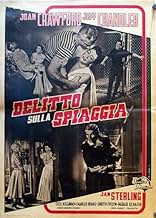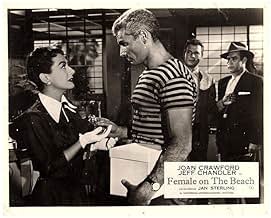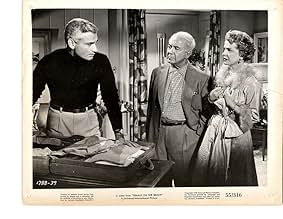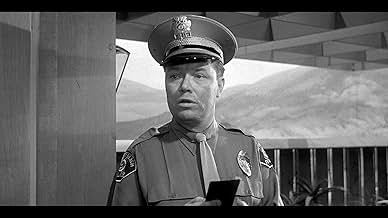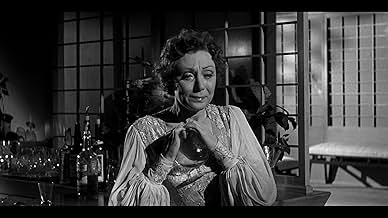NOTE IMDb
6,4/10
1,6 k
MA NOTE
L'emménagement dans une maison sur la plage entraîne Lynn Markham dans le mystère, le danger et la romance avec un garçon de plage aux motivations douteuses.L'emménagement dans une maison sur la plage entraîne Lynn Markham dans le mystère, le danger et la romance avec un garçon de plage aux motivations douteuses.L'emménagement dans une maison sur la plage entraîne Lynn Markham dans le mystère, le danger et la romance avec un garçon de plage aux motivations douteuses.
- Réalisation
- Scénario
- Casting principal
Nan Boardman
- Mrs. Gomez
- (non crédité)
Helene Heigh
- Cleaning Woman
- (non crédité)
James Hyland
- Cop
- (non crédité)
Judy Pine
- Woman at Beach
- (non crédité)
Jack Reitzen
- Boat Attendant
- (non crédité)
Romo Vincent
- Pete Gomez
- (non crédité)
Avis à la une
Few case studies of Hollywood stardom rival Joan Crawford's in their curiosity. A certified star from the time of last silent movies and the first talkies, she fell from favor more than once only to be restored in ever newer incarnations, largely through the boundless reservoirs of her will.
And if there is an era that defines the Crawford that we remember most vividly, it's the decade-plus, from her Oscar-winning turn as Mildred Pierce in 1945 through her last `really top' movie, The Story of Esther Costello in 1957. In her valiant assault, as she moved into middle age, against time's winged chariot, she had vehicles built around her that helped define the canons of camp but retain a fascination that transcends camp. This dozen or so includes: Humoresque, Flamingo Road, her second Possessed, The Damned Don't Cry, Harriet Craig, This Woman Is Dangerous, Sudden Fear, Torch Song, Queen Bee and Autumn Leaves. Though we may howl at some of them (or at parts of them, for they range from rather good to quite dreadful), we're always aware at times discomfitingly so of the human drama that underlies and links them all: the Joan Crawford story.
In Female on the Beach, she plays a recent widow taking up residence in the coastal California home her wealthy husband owned. Her arrival proves ill-starred, for a broken railing on its deck marks the spot where its previous tenant another woman battling age and isolation plunged to her death. Did she jump or fall or was she pushed? It unfolds that she had fallen prey to a youngish beach bum (Jeff Chandler) operated by a pair of older con-artists (Cecil Kellaway and Natalie Schafer); Crawford is targeted as their next mark.
Obsessively guarding her privacy, however, she proves to be a tough nut to crack. Her too familiar realtor (Jan Sterling) is swiftly shown the door when she makes the mistake of taking Crawford for granted. And Chandler, turning up unbidden in Crawford's kitchen one morning, encounters that same rough hide; asked how she likes her coffee, she icily replies `Alone.'
But tanned muscles and prematurely grey temples do not count for nothing in affluent oceanside communities, so Chandler slowly wins over the armored Crawford. But the course of true love never did run smooth, as the Bard of Avon warns us. Crawford just happens to find the dead woman's indiscreet diary (it's hidden away behind a loose brick in the fireplace!), a sad yarn of being cheated in card games and bilked for loans by the larcenous old couple while being strung along by Chandler.
No fool she, Crawford hands the gigolo his walking papers. But then she sinks into a sump of liquor and self-loathing, staggering around waiting the phone to ring like a torch-carrier out of a Dorothy Parker story. Finally, of course, Chandler does call and, better yet, wants to marry her! But fate has a few final cards to deal, including an uninstalled fuel pump Crawford had bought for Chandler's boat....
That staple of genre cinema, the woman-in-jeopardy thriller, generally features dithery, hysterical young things as straw victims. Crawford in jeopardy, by contrast, turns all the conventions upside down. The coquettish bulldozer she has constructed of herself at this menopausal juncture in her life, with her face as fiercely painted as a Kabuki mask, seems designed to repel to crush any threats. (Of course, like most such postures of domination and intimidation, It's a construct of fear her fears of falling short as a serious actress, as a mother, as a woman; fears of aging and no longer being able to lure her directors and costars between the sheets; fears of not mastering her own unachievable goals.) The facade of control and self-sufficiency proves all the more arresting when it comes under siege from the cumbersome twists and turns of these situations held over from nineteenth-century melodrama.
Hence, Female on the Beach and its ilk. An indomitable woman of a certain age flies solo into the perils of mid-life, only to triumph against all odds. That was the life Crawford was living at mid-century, the life reflected in these films, by turns appalling and transfixing. Not since the Brothers Grimm has such a string of cautionary tales been issued.
And if there is an era that defines the Crawford that we remember most vividly, it's the decade-plus, from her Oscar-winning turn as Mildred Pierce in 1945 through her last `really top' movie, The Story of Esther Costello in 1957. In her valiant assault, as she moved into middle age, against time's winged chariot, she had vehicles built around her that helped define the canons of camp but retain a fascination that transcends camp. This dozen or so includes: Humoresque, Flamingo Road, her second Possessed, The Damned Don't Cry, Harriet Craig, This Woman Is Dangerous, Sudden Fear, Torch Song, Queen Bee and Autumn Leaves. Though we may howl at some of them (or at parts of them, for they range from rather good to quite dreadful), we're always aware at times discomfitingly so of the human drama that underlies and links them all: the Joan Crawford story.
In Female on the Beach, she plays a recent widow taking up residence in the coastal California home her wealthy husband owned. Her arrival proves ill-starred, for a broken railing on its deck marks the spot where its previous tenant another woman battling age and isolation plunged to her death. Did she jump or fall or was she pushed? It unfolds that she had fallen prey to a youngish beach bum (Jeff Chandler) operated by a pair of older con-artists (Cecil Kellaway and Natalie Schafer); Crawford is targeted as their next mark.
Obsessively guarding her privacy, however, she proves to be a tough nut to crack. Her too familiar realtor (Jan Sterling) is swiftly shown the door when she makes the mistake of taking Crawford for granted. And Chandler, turning up unbidden in Crawford's kitchen one morning, encounters that same rough hide; asked how she likes her coffee, she icily replies `Alone.'
But tanned muscles and prematurely grey temples do not count for nothing in affluent oceanside communities, so Chandler slowly wins over the armored Crawford. But the course of true love never did run smooth, as the Bard of Avon warns us. Crawford just happens to find the dead woman's indiscreet diary (it's hidden away behind a loose brick in the fireplace!), a sad yarn of being cheated in card games and bilked for loans by the larcenous old couple while being strung along by Chandler.
No fool she, Crawford hands the gigolo his walking papers. But then she sinks into a sump of liquor and self-loathing, staggering around waiting the phone to ring like a torch-carrier out of a Dorothy Parker story. Finally, of course, Chandler does call and, better yet, wants to marry her! But fate has a few final cards to deal, including an uninstalled fuel pump Crawford had bought for Chandler's boat....
That staple of genre cinema, the woman-in-jeopardy thriller, generally features dithery, hysterical young things as straw victims. Crawford in jeopardy, by contrast, turns all the conventions upside down. The coquettish bulldozer she has constructed of herself at this menopausal juncture in her life, with her face as fiercely painted as a Kabuki mask, seems designed to repel to crush any threats. (Of course, like most such postures of domination and intimidation, It's a construct of fear her fears of falling short as a serious actress, as a mother, as a woman; fears of aging and no longer being able to lure her directors and costars between the sheets; fears of not mastering her own unachievable goals.) The facade of control and self-sufficiency proves all the more arresting when it comes under siege from the cumbersome twists and turns of these situations held over from nineteenth-century melodrama.
Hence, Female on the Beach and its ilk. An indomitable woman of a certain age flies solo into the perils of mid-life, only to triumph against all odds. That was the life Crawford was living at mid-century, the life reflected in these films, by turns appalling and transfixing. Not since the Brothers Grimm has such a string of cautionary tales been issued.
I've seen this film exactly twice on TV late at night. If it isn't in print anywhere (it doesn't appear to be currently) it should be. Joan is at her campy, over-the-top best in this bizarre story of a woman, her love interest, and a couple truly strange neighbors (one of whom would later become "Lovey" on Gilligan's Island). The dialog alone is enough to make it worth seeing. Jeff Chandler is at his studly best too. So much of Joan's work is out on DVD and hopefully this film will be too some day. If you're a Crawford fan and you've never seen Female on the Beach (get a load of that title!) you'll be thrilled by this seemingly "lost" movie. You can't beat a film with a line like, "I wouldn't have you if you were hung with diamonds upside down!"
Although this drama is a sleeper, you will find the clothing spectacular. I see the only reason to make this picture was to showcase those famous shoulders. Every evening dress is a masterpiece and the plot secondary only to anything Joan wears in this film. As you may expect, Ms. Crawford plays the "rich bitch" role to the hilt too. I had to love the role played by Natalie Schaefer, she's just too delicious in this role. No Joan Crawford drag party would be complete without this gem playing in the background. And if you can't arrive in a stunning frock similar to ones worn by her in this flick, you're not invited !!
Glossy trash has wealthy, beach front-living Joan Crawford wooed by shady gigolo Jeff Chandler. Low-brow fun, an adaptation of Robert Hill's play "The Besieged Heart", with steamy clinches and page after page of florid dialogue. Director Joseph Pevney seems to be a perfect match for Crawford: he's obviously tough on the unyielding actress and doesn't let her get away with many "Mildred Pierce"-isms. Crawford also seems to have been personally swayed by hunky Chandler, who doesn't let her hog the spotlight. However, neither star is guided with a trace of self-effacing humor, which turns the proceedings into straight-faced camp. Some of the lines are howlers. **1/2 from ****
This film is a lot like an extended Perry Mason episode, which isn't surprising since it's from exactly the same era. I would add, also, that it's beautifully photographed in a noir style.
I have a friend who pointed out that the first half of the movie consists of Joan Crawford repeatedly throwing people out of her house, which is kind of fun to note; perhaps it's an indication of a bit of clumsiness in the script. One could also perhaps say that Crawford leans a bit too much on toughness in her characterization and not enough on the bewilderment the character would have felt as she unwittingly walks into the situation she finds herself in.
The film does keep the suspense going, though, in that it continues to fan the ambiguity of who the house's previous occupant (recently dead as the movie starts) really was and what her relationship was to the various supporting characters. The film is full of manipulative characters with mixed motives, so you find yourself drawing conclusions about the dead character, but then resisting those conclusions because it seems like you're being led to them by pretty slippery characters.
Overall, the film is definitely worth a look; sums up the type of movie Joan Crawford was best known for. To get a look at her lighter side, try "Love on the Run," one of a handful of comedies she did, in which she co-stars with Clark Gable.
I have a friend who pointed out that the first half of the movie consists of Joan Crawford repeatedly throwing people out of her house, which is kind of fun to note; perhaps it's an indication of a bit of clumsiness in the script. One could also perhaps say that Crawford leans a bit too much on toughness in her characterization and not enough on the bewilderment the character would have felt as she unwittingly walks into the situation she finds herself in.
The film does keep the suspense going, though, in that it continues to fan the ambiguity of who the house's previous occupant (recently dead as the movie starts) really was and what her relationship was to the various supporting characters. The film is full of manipulative characters with mixed motives, so you find yourself drawing conclusions about the dead character, but then resisting those conclusions because it seems like you're being led to them by pretty slippery characters.
Overall, the film is definitely worth a look; sums up the type of movie Joan Crawford was best known for. To get a look at her lighter side, try "Love on the Run," one of a handful of comedies she did, in which she co-stars with Clark Gable.
Le saviez-vous
- AnecdotesShortly before the film was made, Joan Crawford was dating the president of Universal Pictures, who offered her the role. She also was given her choice of leading man, and she selected Jeff Chandler.
- GaffesThe type of doorbell that is featured prominently in Crawford's beach house, with four large chime tubes, in reality makes a very different sound than the doorbell sound effect that is heard on the soundtrack whenever the bell is rung.
- Crédits fousThe main actors names, and the film's title are washed away by ocean waves.
- ConnexionsFeatured in Joan Crawford: The Ultimate Movie Star (2002)
Meilleurs choix
Connectez-vous pour évaluer et suivre la liste de favoris afin de recevoir des recommandations personnalisées
- How long is Female on the Beach?Alimenté par Alexa
Détails
- Durée1 heure 37 minutes
- Couleur
- Rapport de forme
- 1.85 : 1
Contribuer à cette page
Suggérer une modification ou ajouter du contenu manquant

Lacune principale
By what name was La Maison sur la plage (1955) officially released in India in English?
Répondre
